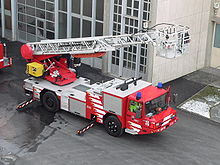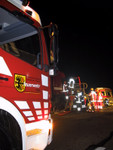Fire engines in Switzerland


Due to the organization of the fire brigade in Switzerland , the vehicle types of the fire brigades are at least in principle firmly defined.
Community / volunteer fire brigades normally have a tank fire engine (TLF), a pioneer vehicle ( PIF) for technical assistance, a medical vehicle (SAN) and a turntable ladder (ADL).
Colours
The fire engines in Switzerland are usually painted red. The canton of Zurich is an exception , where new fire engines have not been delivered in red since the 1990s. According to a study by the canton's building insurance , the fire engines are colored lemon (a mixture of yellow and green), as this color is more noticeable in road traffic than the previous red. However, in other parts of the country, such as Ticino , the an The canton of Schaffhausen bordering Zurich or in French-speaking western Switzerland , fire engines in yellow-green can be found. Vehicles of the oil and chemical service are painted yellow with a purple stripe.
designation
In Switzerland, fire fighting vehicles are usually named in such a way that the type of the vehicle is abbreviated and followed by the two-digit year when it was put into service. TLF 89 therefore means that it is a tank fire engine which was put into operation in 1989. If a fire brigade has several vehicles of the same type from the same year, the vehicles are also numbered consecutively. ADL 93/2 therefore means that it is a turntable ladder from 1993, where at least two (mostly identical) devices from that year are in use. Many fire departments use the numbering without any reference to the year. In the Bern fire brigade, for example, the designation TLF 84 fix is assigned to the Bern-Land company and therefore has no relation to the commissioning of the fire truck. Occasionally the fire engines are given names or are named in smaller fire departments after the vehicle brand or type. Due to the fact that only very few fire engines are procured according to a standard in Switzerland, the names also differ from one another.
Respiratory protection vehicle (ASF)
The respiratory protection vehicles are a modification of the PTF, they have respiratory protection devices that can be put on while driving, and there are also larger quantities of spare bottles in an ASF. Normally, 6 AS device carriers can equip themselves in one ASF at the same time. Depending on the vehicle, additional devices are also carried along. In addition to the AS devices, there is also additional AS material (troop supervisor case, handheld radios, rescue devices, escape hoods, ...) as well as drinks for longer use.
Turntable ladders (ADL)

A turntable ladder essentially consists of a vehicle on which a ladder with a climbing height of usually around 30 meters is attached. Often there is a basket at the end of this ladder from which fire-fighting from above is possible using water cannons. It is also used to rescue people from higher floors. A stretcher can be mounted horizontally on the basket for this purpose.
The main control station is usually mounted on the left of the bogie. Clear displays and control elements, which the machinist can easily operate even with gloves, are important features of the militia suitability of such a device. A second control station is located in the cage for precise control of the ladder. In addition to rescue and extinguishing tasks, turntable ladders can also be used to explore or illuminate a damaged area.
Command vehicles (ELF)
Command vehicles are used by the operations management. They are equipped with communication and management infrastructure. Documents on dangerous goods are usually also available so that the operations management can optimally assess a hazard at any time and react accordingly. In some fire brigades in Switzerland, such as the Bern professional fire brigade, the abbreviation "ELW" is also used for command vehicle.
Emergency vehicle (HLF)
A rescue vehicle brings, in addition to the equipment of a tank fire engine , additional equipment ( rescue kit ) for the technical rescue of people. The universal applicability of this type of vehicle also reduces personnel costs when using it for the first time.
Aerial rescue vehicle / aerial rescue (HRF or HBR)

Lifting rescuers often expand the vehicle fleet and, with a climbing height of up to 112 meters ( Bronto Skylift ), are very well suited for rescuing people from high-rise buildings. The lifting arms also have a permanently installed water supply line and thus enable fire fighting from above, even in the case of very large fires and fires at great heights (also in remote-controlled monitor mode).
Fireboat
There are special fire boats for use on lakes or rivers . The boats on the small lakes in Switzerland are accordingly also small and cannot be compared with those you see in larger harbors by the sea. The deletion from the water hardly occurs in Switzerland. The use is limited to rescue operations or the oil weir . For larger deployments near a body of water, the fire boat can also be used as a pump (e.g. Schweizerhalle fire in 1986).
The two largest fire engines in Switzerland are stationed in the Basel region . The Basel boat is moored in the middle of the city of Basel, while the Basel-Landschaft canton boat is permanently located above the Birsfelden lock on the power plant island. Both ships are operated by the Basel-Stadt professional fire brigade .
Command vehicle (KOWA)
Command cars are used to bring the officer on call or the chief of operations to the scene of operations. Depending on the fire brigade, the KOWA is right at home with the on-call officer so that it can drive directly to the scene of the incident. In a KOWA there are means of communication (radio, command station atel), deployment documents / plans, command vests, medical supplies (including AED ) and mostly certain barrier material. The KOWA is usually a passenger car, but it is equipped with the usual special signals.
Fire trucks (LF)
Fire trucks bring extensive fire fighting equipment , but are usually not equipped with a (or possibly a very small) water tank. Equipment includes powder and foam extinguishers . Hoses, nozzles and hydrant sets as well as safety and lighting material are also housed on such vehicles. A smaller pump can be installed or a pump can be carried on a trailer (often type 2, with a VW Beetle engine of the civil defense type).
Material handling vehicles (MTF)
The fire brigades often have a great need to bring material to different locations. This is ensured by material transport vehicles. Material transport vehicles are available in a wide variety of sizes, from small feeder vehicles to large transport trucks that can be used to bring heavy equipment.
Motor syringes (MS)
The motorized syringes used by the fire brigades in Switzerland still often come from former army and civil defense stocks. These motorized syringes are housed on trailers and run on gasoline. In particular, these syringes are still frequently used today for aspirating from water, since they are relatively small and mobile and in this way can be stationed close to water without any major problems.
Passenger transport vehicles (PTF) / crew transporters (MT or MaTra)
Passenger transport vehicles are used to bring fire fighters to the damage site (place of use). In addition, some breathing apparatus is often housed on these vehicles.
Pioneer vehicles for technical assistance (PIF)
Pioneer vehicles are used for technical assistance . In particular, equipment such as chainsaws , lifting bags, hydraulic scissors and spreaders can be found on it , but usually also extinguishing material and barrier material. Some pioneer vehicles also have oil weir equipment on board. The Pratteln fire brigade vehicle shown has a tank with an oil binding agent on the rear and can be equipped with the Oil Tiger if there is an oil trail.
Ambulance vehicles (SAN)
A first aid vehicle is used to provide first aid to injured fire victims and fire brigade members. It contains important equipment for emergency aid and has various equipment for first aid ready. Blankets and drinks can also usually be found on a medical vehicle.
Special fire truck (SLF)

A special fire truck carries special extinguishing agents in addition to the equipment of a tank fire engine. For example, for chemical incidents involving chlorine , bromine or other halogens, certain amounts of sodium thiosulphate are added to the extinguishing water in order to increase the solubility of the substances in the water mist.
Road rescue vehicle / road rescuer (SRF)
The road rescuer is needed in traffic accidents when people are trapped. SRF are mostly smaller vehicles (5–7 tons) with which it is possible to move quickly even in traffic jams. The equipment of the SRF is specially tailored for the quick and gentle rescue of people in vehicles. On this vehicle you will find hydraulically driven scissors, spreaders and cylinders as well as all material that is used in road rescue. In addition to these tools, there is also a small tank on the vehicle to ensure that the triple fire protection can be created quickly. Road rescuers are special vehicles that are used at road rescue bases.
Fire fighting vehicles (TLF)
Tank fire engines bring their own pump, usually of type 3, with a minute output of around 2500 liters and a water tank with a volume of around 2300 liters. Hoses, nozzles, hydrant sets as well as material for traffic control and safety, for technical assistance and some breathing apparatus are also housed on such a vehicle. As a rule, ladders can be found on the roof of the TLF.
Universal fire fighting vehicles (ULF)
At base fire brigades, there is also a universal fire fighting vehicle (ULF) in the vehicle fleet, which basically provides the same extinguishing agent as a TLF. An ULF is just a "shoe size bigger". Such vehicles often reach lengths of up to 10 meters and weights of around 30 tons. A type 4 water pump with a minute output of up to 4200 liters can also be part of the scope, as can a 5000 liter water and a 1500 liter foam extract tank. In the canton of Zurich, the equipment of an ULF also includes a powder extinguishing system with 1500 kilograms of powder. Of course, such vehicles can also be made smaller, but often they are not, and are therefore only used for major events. In some fire brigades in Switzerland, similar vehicles are simply used as GTLF (spellings such as G-TLF or (G) TLF are not uncommon). Such a vehicle is used in the "street rescue train" of the Bern professional fire brigade. It is also equipped with a road guidance and warning board at the rear, thus protecting the emergency services. It is often used for rescues and vehicle fires on the national road network.
Traffic department vehicles (VAF)
Traffic department vehicles bring material for traffic safety and regulation as well as barrier material. If necessary, they can also be easily used as transport vehicles.



